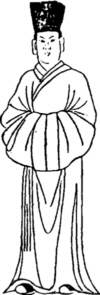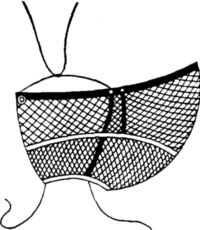Chapter 43 Section 2 men's clothing
Like the feudal rulers of past dynasties, after Zhu Yuanzhang ascended to the throne, he had long forgotten that he was once a part of the poor people. While strengthening the privileged position of the ruler, he regarded the people as sluts, and believed that the common people were just "going for things." Those who serve to serve the Lord."In the 15th year of Hongwu (1382 A.D.), the people of Zhejiang, Zhejiang and Jiangxi announced the announcement: "Those who are our people should know their duties (duties, obligations), and those who pay the land tax and labor for the superior are their duties. If you settle down, you will protect your parents and wives, your family will be prosperous, and you will be a loyal, filial, benevolent and righteous people." Otherwise, not only the laws of the country, but also "the way of heaven will not be tolerated" (Vol. 150 of "Records of Ming Taizu").Based on this point of view, it is reflected in how restrictive people's clothing is.In the early Ming Dynasty, it was stipulated that common people could borrow nine-rank official clothes for marriage, and usually wear variegated collars.Men's and women's clothes are not allowed to use yellow or black, and gold embroidery, brocade, silk, and silk are not allowed.Boots must not be patterned or decorated with gold thread.Jewelry shall not be made of gold, jade or pearls.Common people's hats are not allowed to use tops, and only crystal and fragrant wood are allowed to be used for hat beads, and gold and jade are not allowed.Peasants can wear silk, gauze, silk, and cloth, but merchants are only allowed to use silk and cloth.The length of the clothes, the length and width of the sleeves are specified.These restrictions, by the middle and late Ming Dynasty, were mostly banned but not stopped.
Men's casual clothes in the Ming Dynasty generally used gowns. Although they had a variety of shapes, they did not take off the characteristics of a large front, a right lapel, wide sleeves, and a length below the knee.The clothes of the common people are usually shirts and jackets on the upper body, trousers on the lower body, and cloth skirts.Men from aristocratic families mostly used silk and brocade as casual clothes, embroidered with various patterns.Most of these patterns have auspicious meanings.It is common to insert a round "longevity" character between the cloud and the bat. The "bat" and "fu" of the bat are homophonic.There are also some deformed and exaggerated patterns such as peony and lotus. Peony is the "flower of wealth" and has always been regarded as a symbol of prosperity, beauty and happiness.The lotus is a favorite flower of the Chinese people, and is regarded as the "gentleman of flowers" and also regarded as the "sacred flower of Buddhism" by Buddhism.Some branches, leaves and buds are interspersed between these flower shapes. The patterns are unique, implying happiness and sacredness, and were deeply loved by people at that time.
Confucian scholars, students, supervisors and other scholars mostly wear shirts or straight skirts.According to the regulations of the Ming Dynasty, the shirts of students are made of jade-colored silk, with wide sleeves, black edges along the edges, and black soft scarf hanging belts.Straight skirt is a kind of gown with oblique collar and large sleeves. It is named because the middle seam of the back goes straight to the bottom.The down-and-out boy Zhou Jin and the up-and-coming Wang Juren are both wearing straight gowns, but one is the old "primary color (black) silk" that has been worn out in many places, and the other is the brand new "sapphire blue satin" (Second Chapter ).In addition, there are those who wear Yesa, Cheng Ziyi, girdles and hoods.Yesa is also a kind of robe in the Ming Dynasty. It has cross-collared collar, large placket, and long sleeves that go over the hands. The upper and lower garments are connected. A kind of casual clothes.In the late Ming Dynasty, scholar-bureaucrats also wore them at banquets and social occasions.Cheng Ziyi is the daily clothing of literati and Confucian scholars in the Ming Dynasty. It has a long body, connected from top to bottom, with seams at the waist and pleats folded under the seams, wide sleeves, and a slanted collar to cover the front.Take care is a short-sleeved garment that is slightly longer than a gown.There are two kinds of hoods, one with double breasts, which is worn by riders on horseback, and ordinary soldiers and infantry are not allowed to wear them;

Straight coat (Ming figurines)
During the Chenghua period (1465-1487 A.D.), a kind of "horsetail skirt" was popular in Beijing.This skirt originated in Korea.The skirt is bulky, comfortable and beautiful.After it was introduced to the capital, many people in the capital "buy and serve it".In the beginning, there were very few people who could weave, and the price was high, so it was only popular among wealthy businessmen and princes.Afterwards, merchants and sellers increased, "therefore there was no price, no cheapness, and those who obeyed became more and more prosperous." In the last years of Chenghua, even the court officials "more and more obedient ones" (Lu Rong's "Shuyuan Miscellaneous Notes").

net towel
The towels and hats used by ordinary people in the Ming Dynasty not only adopted the styles of the previous generation, but also had new creations and various shapes.The most commonly used net towel is a kind of net cover tied with hair in a bun.It is shaped like a fishing net and is mostly woven with black string, ponytail and heddle.The mouth of the towel is made of cloth, and there is a small metal ring next to it, which is used to pass through the rope, and the belt can be tightened to send out the net.Wearing a net scarf is another sign of a man's adulthood.Net towels are usually lined inside the crown, or they can be used alone and exposed outside.In the twenty-fourth year of Hongwu (1391 A.D.), Zhu Yuanzhang, the emperor of the Ming Dynasty, visited in disguise and saw a Taoist priest weaving a net towel.Zhu Yuanzhang asked: "What is this thing?" The Taoist replied: "This is a net towel, and it is used to wrap the head, so that all hair will be in place." Zhu Yuanzhang was very satisfied with the words "All hair is in place". "The next day, the net towel was ordered to be taken, and the thirteen chief ministers were issued. No matter whether they were high or low, they were all wrapped in net towels, so the emperor often wore net towels" ("Ming History · Yufu Zhi").There is also a net towel with an opening on the top. When in use, the hair bun is exposed outside through the opening, and the opening is also tied with a rope, which is called "Yitong Shanhe".The net towel was used the longest in the Ming Dynasty, and it was not compelled to be removed by the rulers of the Qing Dynasty until the death of the Ming Dynasty.There are also Confucian scarves and Sifang Pingding scarves, which are worn by scholars.In the early Ming Dynasty, Zhu Yuanzhang ordered the scholars to "serve the four belt scarves" ("History of Ming Dynasty·Yu Fu Zhi").In the third year of Hongwu (1370 A.D.), it was changed to the Sifang Pingding scarf, taking its auspicious meaning of Sifang Pingding.This is a foldable boxy cap made of black leno.The flat-topped scarf is worn by lower-level officials such as Zaoli and ministers.Soft towels, also known as Tang towels, are made of soft silk yarn, tied at the back and hung on both sides, and are relatively popular.In addition, there are official towels, Han towels, swastika towels, and Zhuge towels.Hats include brown-knotted straw hats, sunshade hats, round hats, and red and black tall hats worn by executives in the yamen.
There were strict restrictions on the wearing of shoes and boots in the Ming Dynasty.Boots are used as official uniforms, no matter they are made of leather, felt, satin or silk, they must be dyed black, with thick soles made of wood, leather or hard paper, and coated with white powder, the so-called "foundation soap boots".Soap boots can be worn by worshipers in the teaching workshop and in front of the imperial court, soap boots can be worn by Confucian scholars, and school captains can also wear soap boots when they are on duty, but they are not allowed when they go out.In the Ming Dynasty, brocade clothes and guards all wore white leather boots.They disregard human life and do many evils. When the people in the capital see the white leather boots, they are all afraid of them like tigers.In the 20 years of the early Ming Dynasty, the common people could also wear boots, but later the folk boots were "cut ingeniously, with gold thread and blue strips embedded in the mouth". Artisans, infantrymen, miscellaneous workers, etc. are not allowed to wear boots, only leather straps? ("History of Ming Dynasty Yufu Zhi").People in the cold northern regions can wear cowhide straight seam boots.No decorations are allowed on the boots, nor can they be dyed black to distinguish them from official boots.Men and women in Guangdong, Fujian and other places in the south mostly wear wooden clogs, and some even paint colorful paintings on them, which is unique.

Straight coat (Ming figurines)

net towel
